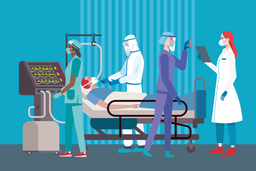Computational Approaches for Predicting Fever and Fever-Associated Adverse Events using Serial Temperature Data Measurements
TECHNOLOGY NUMBER: 2021-343

OVERVIEW
Early fever detection using continuous temperature monitoring- Uses a patient-specific rolling baseline that can capture circadian rhythm disruptions
BACKGROUND
There is a critical need to improve clinical outcomes of hospitalized patients by detecting fevers earlier than current clinical standard-of-care (SOC). This is especially important for cancer patients receiving myelosuppressive chemotherapy or CAR T-cell therapy because they are at a high risk for serious adverse events (infections, cytokine release syndrome (CRS) etc.) detectable by the presence of a fever. Also, for patients developing neutropenic fevers or sepsis, a delay in fever detection and hence treatment on the order of just hours leads to increased mortality.
INNOVATION
A computational approach has been developed by University of Michigan researchers to predict a fever several hours before it occurs using continuous temperature measurements from wearable sensors. This enables earlier detection of adverse clinical events compared to current clinical SOC as well as remote patient monitoring in an outpatient setting. The approach uses mathematical modeling to detect subtle changes in temperature relative to the patient's baseline (before a fever occurs) circadian rhythm. The model can also detect a transient rise in temperature that occurs prior to a sustained fever.
The model provides significant improvement over clinical SOC by detecting more adverse fevers events and detecting them earlier. It also has the benefit of using a patient-specific rolling baseline that intrinsically captures circadian rhythm disruptions, making it useful for both inpatient and outpatient settings. This computational approach could be used in wearable medical devices and remote patient monitoring systems for fever detection. Specifically, it could facilitate safer outpatient delivery of CAR T-cell and other emerging therapies (ex. BiTEs) associated with an increased risk of CRS.
-
expand_more mode_edit Inventor (8)Caleb MayerChristopher FloraDaniel ForgerJonathan TylerMuneesh TewariSung ChoiThomas BraunVibhuti Gupta
-
expand_more cloud_download Supporting documents (1)Product brochureComputational Approaches for Predicting Fever and Fever-Associated Adverse Events using Serial Temperature Data Measurements.pdf